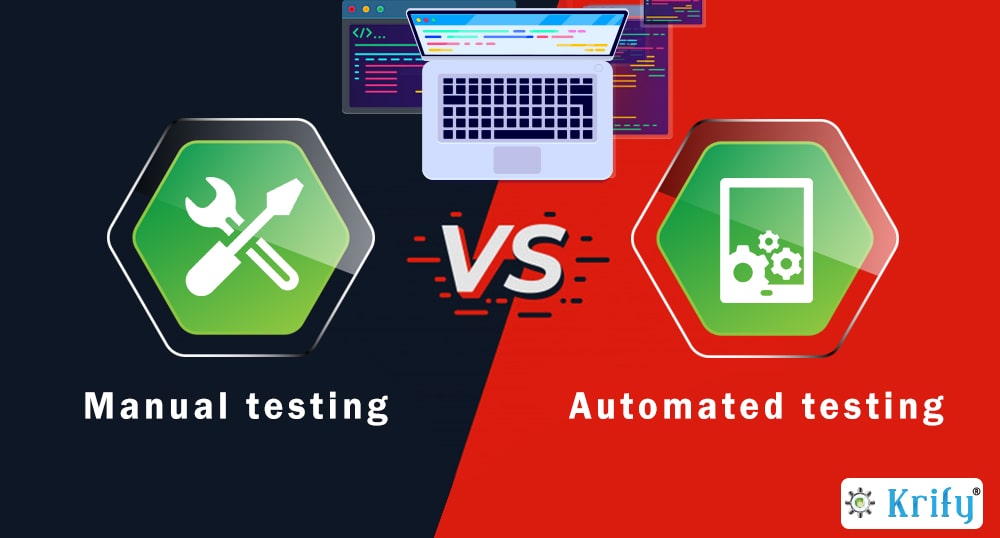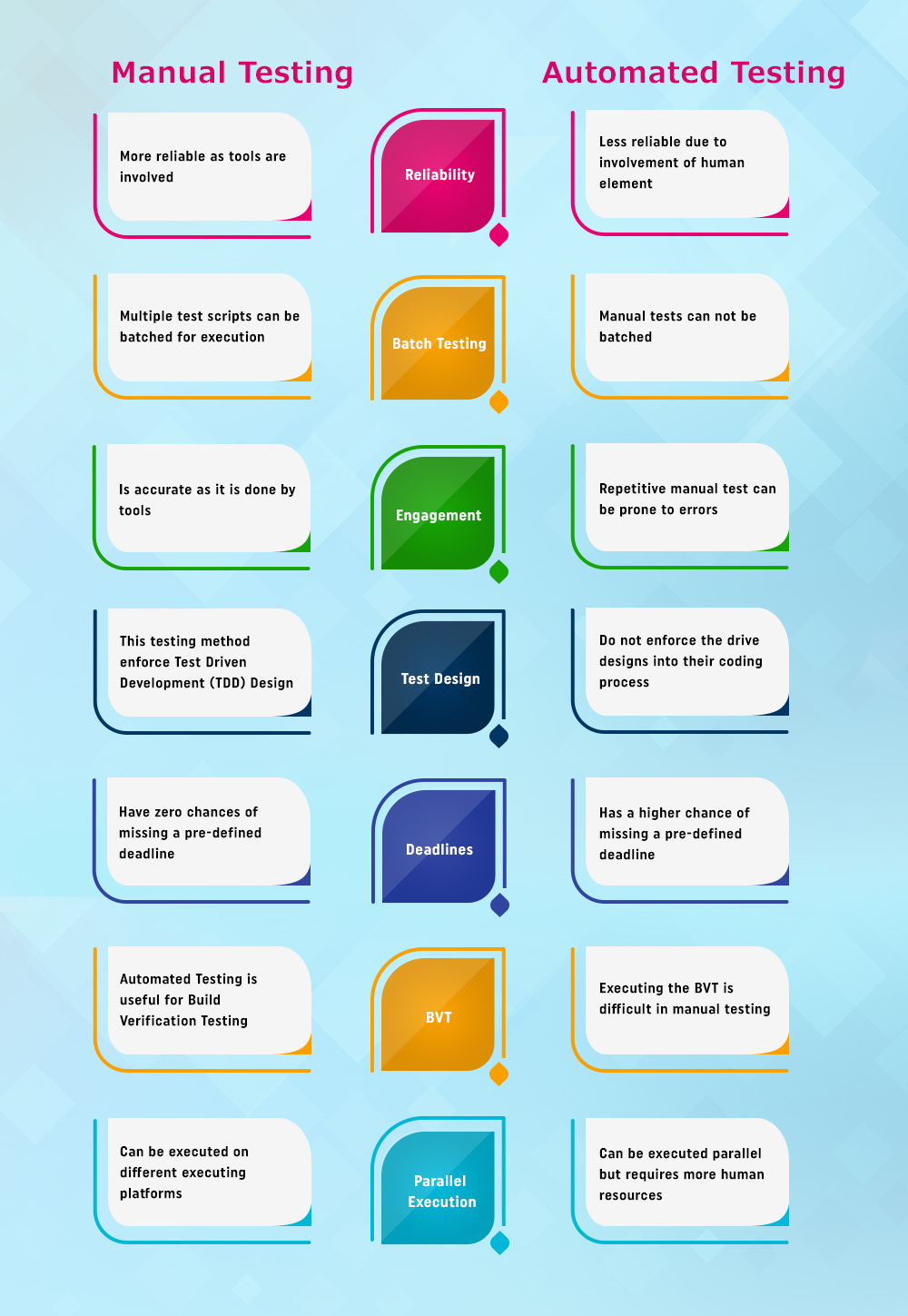In general, when considering Manual vs Automation Testing, every project has three essential aspects to consider i.e cost, time, and quality. The major goal of any project is to achieve high-quality results at an affordable cost within a reasonable time to complete the project.
Directly or Indirectly the quality is measured ultimately by testing the product. Also, the testing helps to know, the expectations and reality gaps among the developer to the client. Within the current article, we are going to pin-point 2 major kinds of testing as follows.
- Automated Testing
- Manual Testing
We all know, Testing is the fundamental element of any project. But most of the people are not aware of what to choose and when to choose among manual or either automated testing. It’s very important to know the difference between manual testing and automated testing so that it helps to optimize the cost and time of the project.
It was a well-known fact that both of them have their own benefits and disadvantages. If we consider Manual testing, the tester has to sit in front of the screen and go through each module. In contrast, testers find automated testing much more powerful, as automated tools/software perform the test cases automatically. Basing on several factors like budget, timeline, and human resource….You could choose the right type of testing to archiving your goals. Let’s look inside how we can consider these…
What is Automated Testing?
Automated testing is a process that makes use of automation testing tools, scripts and software to perform pre-scripted tests on applications, then compares the test results to the expected levels and report it to the testers. You can perform test automation by writing scripts with codeless tool automation tool or with selenium. These automation testing tools also have the record and playback features which help you to record all your testing activities. By performing the repeated predefined actions the results will be compared. If the output and the expected results same, your product is working well as it supposed to do work. However, all automated testing requires some manual testing at first to create initial testing scripts.
What are the types of Automated Testing?
- Data Driven Testing: For this testing, the same functionalities needed to be validated with lots of different inputs and large datasets (for example login, sign up, search, etc).
- Load testing: This helps to determine a system’s performance in real-time while loading the application. It will find how the system behaves when multiple users access it simultaneously.
- Performance Testing: Performance testing helps to get the speed, scalability and stability of the application. The goal is to reduce any performance bottlenecks. This requires simulation of thousands of simultaneous users.
- Regression Testing: Because of frequent code changes and therefore the ability to run the regressions in a timely manner.
- Repeated Execution: The repeated execution of a task is the best-automated testing.
Advantages of Automated Testing:
- In automated testing, most of the process is automatic which makes it into an efficient and fast testing process.
- The level of productivity is improved with this process and is quick to provide accurate testing results.
- The automated testing tactics are supported by a majority of applications.
- With automated testing, you can spot more bugs
- The user can record the process of automated testing, enabling them to reuse and execute it further.
Disadvantages of Automated Testing:
- As there is no human element in automated testing, it becomes difficult to get appropriate insight into the visual aspects including the fonts, colours, and other user interface elements.
- The advanced tools required for automation testing can be quite pricey.
- There are flaws with every automated testing tool like the test maintenance cost being high.
Summarised points of Automated testing:
- Automated testing is much faster due to using the software.
- Less UI feedback.
- It could be costly at the starting stage, but in the long-term, it will reduce the cost.
- High accuracy result.
- More reliable.
- Programming is required.
- Regression testing is easy due to using tools.
- Once the test requirements are made, it requires the fewer tester to execute test cases.
What is Manual Testing?
Human action manually tests web or mobile applications to uncover defects or bugs in software programs. Testers evaluate various components like design, functionality, and performance by clicking through multiple elements or units of a web application without relying on tools or scripts. This manual process is time-consuming and laborious.
What are the types of Manual Testing?
- Exploratory Testing: In this type of testing the tester’s knowledge, experience, analytics/logical skills, creativity, and intuition is the most essential elements. Poorly written specification documentation and/or a short time for execution will characterize the test. This approach requires the least planning and most test execution.
- Usability Testing: Using this approach we will know how user-friendly, efficient, or convenient the product is for the end users? The goal of this testing is human observation and satisfaction.
- Ad-hoc testing: The testing is performed without any plan or documentation. The output is totally dependent on the skill and knowledge of the tester.
In order to know when to use each type of testing, you need to understand the advantages and disadvantages of each testing. Using the right method at the right time will save your time and will give the best results. So let’s go through advantages and disadvantages of Manual vs Automated testing.
Advantages of Manual testing:
- In comparison to automated testing, manual testing is less extensive and cost-efficient.
- Because of the involvement of the human element, we get accurate user interface feedback in testing.
- The user doesn’t need to change the entire code, in order to make small quick fixes in the app.
- With manual testing, we can get the exact replication of the real user experience on the web and mobile apps.
- The manual testing approach is able to handle difficult use case situations better than the automated testing.
Disadvantages of Manual Testing:
- In manual testing, the choice of recording the testing process is not available and that makes it less efficient.
- Humans handle manual testing, which results in a higher likelihood of changes and errors.
- Sometimes, completing tasks manually can seem complicated and unrealistic, requiring additional time for completion.
Summarised points of Manual testing:
- Testing manually consumes time because it involves manually executing test cases for every aspect.
- The tester can observe the application during testing, making the user-friendliness better.
- Less expensive in the short-term.
- Low accuracy result.
- Less reliable.
- You do not need to program.
- Regression testing is time-consuming and laborious.
- Performing the test cases requires the same amount of time.
Difference Between Manual vs Automation Testing
Conclusion
For optimizing the cost and time required for successful completion of a project, you cannot solely depend on the manual testing or automated testing approach. You may need a right combination of both the testings to get the best output for the product.
Krify, the leading Mobile App Development Company that allows keeping track of your manual vs automation testing efforts. You can view the test execution results of your manual vs automation testing at a single place. It allows you to efficiently collaborate with your team members while performing the testing. If you want to know more about how we use testing, feel free to contact us.
Happy Testing..!









